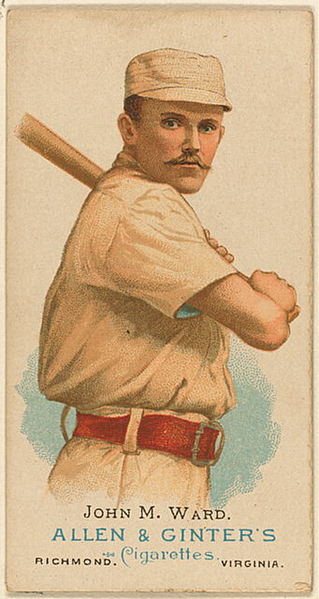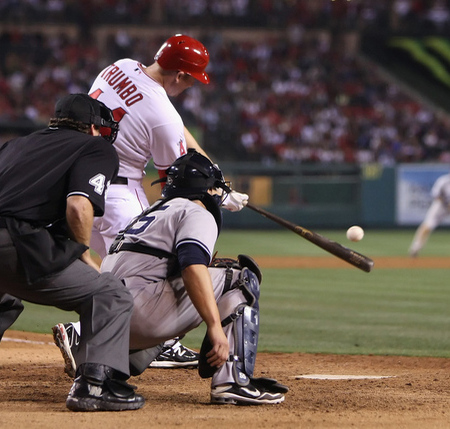But when given a chance to play early this season, what Trumbo did was hit—for both average & power. At first his playing time was sporadic, but as it became clear that he was hitting as well or better than anyone on the team, he became a regular starting outfielder, acquitting himself well enough defensively to more than justify keeping his potent bat in the line-up.
Of course, if you follow baseball at all, you know this story, as well as others associated with the Angels team: Pujols’ grim early season slump, the emergence of rookie baseball culture hero Mike Trout, & more. But thru it all, Trumbo has maintained excellence at the plate, leading the Angels in home runs, runs batted in, & slugging percentage, while trailing only the nonpareil Trout in batting average.
Questions remain about Trumbo, however. Last year was his rookie season, & tho he hit 29 home runs & drove in 87 runs, his batting average was so-so at .254, & more importantly, his on-base percentage was below .300—an anemic .291. Reaching base only 29% of the time is poor performance, & a number of statisticians & analysts consider on-base percentage the most important of the traditional baseball numbers.
So while batting average has long been considered the foremost offensive measure, it has shortcomings; & even more than variances in fielding abilities, its biggest shortcoming is that it doesn’t account for other ways a batter has of reaching base, especially his ability to take a walk. On-base percentage attempts to correct this latter failing by adding hits, walks, hit by pitched ball & dividing this by the total plate appearances (including sacrifice fly balls—which personally I think is a minor weakness of the stat, because it essentially penalizes the batter for something that's a positive result.) Official at bats differs from plate appearances in that at bats only counts hits, errors & outs, & doesn't count walks, hit by pitch or sacrifices one way or the other.
 The walk—a humble thing: reaching base because the pitcher throws four pitches outside of the strike zone. As some of us remember, there are taunts in youth baseball specifically aimed at a batter who seems to prefer to take a walk over trying to swing the bat & get a hit. At various times in baseball history, the walk has been eschewed as something the pitcher did wrong rather than something the batter did right. In Jules Tygiel’s excellent Past Time: Baseball as History, he describes the scoring & statistical systems developed by Henry Chadwick in the late nineteenth century—in fact, most of Chadwick’s systems are still in place today. Chadwick essentially invented batting average & the concept of earned versus unearned runs, & also developed the system of keeping a scorebook, with standardized numbers assigned to each fielder; he also invented the box score.
The walk—a humble thing: reaching base because the pitcher throws four pitches outside of the strike zone. As some of us remember, there are taunts in youth baseball specifically aimed at a batter who seems to prefer to take a walk over trying to swing the bat & get a hit. At various times in baseball history, the walk has been eschewed as something the pitcher did wrong rather than something the batter did right. In Jules Tygiel’s excellent Past Time: Baseball as History, he describes the scoring & statistical systems developed by Henry Chadwick in the late nineteenth century—in fact, most of Chadwick’s systems are still in place today. Chadwick essentially invented batting average & the concept of earned versus unearned runs, & also developed the system of keeping a scorebook, with standardized numbers assigned to each fielder; he also invented the box score.Chadwick, as Tygiel tells us, was British by birth—in fact, his older half-brother was a member of the peerage. Originally an ardent cricket player at a time when cricket still was a popular sport in the U.S., especially among British emigrants, Chadwick became enamored of baseball & championed the sport throughout his life. Interestingly, Chadwick was also much involved with the Reform movement which, as Tygiel reminds us, was as a whole very focused on statistics as a way of improving people’s lot, & there appears to be a moral code behind Chadwick’s statistical system, especially in the concept of “unearned runs,” but also in batting average, since it negates the pure value of putting a ball in play allowing the batter to reach base if a fielder misplays the ball.
Of course, Chadwick’s system also gives the batter no reward for taking a base on balls. In fact, Chadwick was firmly convinced that issuing a walk was solely a black mark on the pitcher & didn’t reflect favorably on the batter in any way. Chadwick developed the concept (long since abandoned) of the “battery error,” in other words, a “misplay” by the pitcher & catcher, & walks were foremost in this category. Chadwick even considered runs that resulted from walks to be “unearned,” tho this particular idea has long since fallen by the way. Of course, Chadwick’s “earned” versus “unearned” runs, while remaining a valid concept to this day, in his formulation was much more of a reflection on the hitting team—thru much of baseball history, including contemporaneously, “unearned” runs have been considered those for which the pitcher isn’t responsible (because they occur due to a fielder’s misplay.) Chadwick’s earlier conception is no doubt due to the fact that cricket statistics are very much focused on runs to the exclusion of other information.
But to return to Mark Trumbo: in 2011, Trumbo couldn’t “take a walk.” He walked a mere 25 times (while striking out 120.) Such a performance, despite his good figures for home runs & rbis, point to two things: first, reaching base only 29% of the time, he was not in a position to score runs as often as he could have been (he only scored 65, which is mediocre, especially with that many home runs); second, a low walk/high strikeout rate typically suggests a player who will be prone to streakiness & inconsistency.
Now it’s a new season, & a season that is now more than half completed. Trumbo’s average as of today stands at .303, almost 50 points higher than last year; his 27 home runs are only two shy of last year’s total, & he still has 67 games left to play—he could conceivably hit 40, which is a total that suggests hitting dominance. His on-base percentage stands at a more than respectable .354—with those 67 games yet to be played, he has drawn one less walk so far than he did all of last year.
But people remain unconvinced. Is this the “real” Mark Trumbo? Of course, the fan is an idealist in the philosophical sense of the word, & the fans who are most involved with statistical analysis are the most intense idealists of all: a study of the numbers will reveal the “real” player behind the transitory player of today, this week, or even this half season. It will reveal the player as he exists in a “world of forms,” in that “place beyond heaven,” to bring Platonic concepts to bear on hardball.
 The “problem” with Trumbo then would be that while his walks have certainly increased, his on-base percentage is still largely driven by his batting average—there’s barely a 50 point spread between the .303 average & the .354 on-base percentage. A spread of at least 70-80 points is considered more desirable, & there are hitters whose performance will yield a spread of over 100 points (10%); for instance, the Cincinnati Reds first baseman Joey Votto has a current batting average of .342 & an on-base percentage of .465—he reaches base in nearly half of his plate appearances!
The “problem” with Trumbo then would be that while his walks have certainly increased, his on-base percentage is still largely driven by his batting average—there’s barely a 50 point spread between the .303 average & the .354 on-base percentage. A spread of at least 70-80 points is considered more desirable, & there are hitters whose performance will yield a spread of over 100 points (10%); for instance, the Cincinnati Reds first baseman Joey Votto has a current batting average of .342 & an on-base percentage of .465—he reaches base in nearly half of his plate appearances!When the spread between the two percentages is wide, it’s always driven by walks of course—being hit by a pitch in most cases doesn’t happen frequently enough to have a major impact on the stat. This benefit of being on base is great, of course: you must be on base to score, & reaching by a walk can advance other runners if there's already someone on first base. If the bases are loaded when the batter draws a walk, it will even drive in a run.
For these reasons, the walk has come to be highly valued in contemporary baseball, especially in the sabremetric community, & on-base percentage (as well as fine-tuned reformulations of the same) is considered the offensive stat amongst stats, to the devaluation of batting average. Interestingly, this isn’t entirely a new thing: in fact the National League players, spearheaded by star player John Montgomery Ward, mounted a successful movement for counting walks as hits in 1887—much to the horror of Henry Chadwick; to his relief, this innovation lasted only a single season.
Is the walk given too much positive value these days? In the Simpson’s parody of Moneyball (which I referred to in my earlier post here), Lisa kicks Bart off the team for hitting a home run when he should have taken a walk, because it’s a higher percentage play. Statistics love a sure thing & abhor chaos—the walk tends toward the former & the ball that’s hit in play certainly carries great potential for the latter; this is in part the underlying concept behind the “Three True Outcomes,” which I wrote about in my The Myths of Strikeouts post. In many senses, the walk has moved to a point diametrically opposed to Chadwick’s conception—rather than being an example of the pitcher’s “error,” or even moral lapse, it’s now an active good on the part of the hitter—a sign of his righteousness.
Will Trumbo continue his dominance? I’m not a prognosticator, & tho I love statistics (& value walks!) I think the answer, like the place beyond heaven, lies beyond the ken of us mere mortals.
All images link to their source
Mark Trumbo about to hit a home run [from SBNation]
graph showing increased runs as a factor of on-base percentage [from baseballprospectus.com]
Henry Chadwick [from Wikipedia]
Yours truly with a very good book
Medieval woodcut depicting man looking beyond the temporal to the eternal [from abyss.uoregon.edu]
Illustration of Platonic Theory of Forms [from scandolon.co.uk]
John Montgomery Ward 1887 baseball card [from Wiki Commons]
Lisa & Bart discuss "moneybart" strategy [from images.wikia.com]






That wonderful picture of someone reaching the edge of the world. I saw it years ago and I've wondered about it's origins for longer than I care to remember! Now I know - well, what there is to be known.
ReplyDeleteWhat's interesting is how if you say it's 16th century one takes it for granted, but if one says it's art nouveau one's view of it changes and it makes even more sense (even if it's slightly less interesting).
ReplyDeleteHi Dominic: That is such a compelling image indeed! & yes, I agree that it is more compelling coming from a world in which it's a "serious" image so to speak than from some pre-Raphaelite or art nouveau re-imagining of same. Thanks!
ReplyDelete